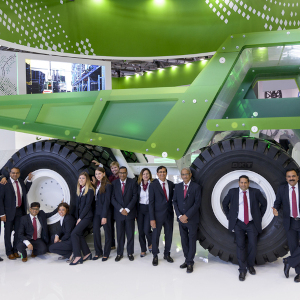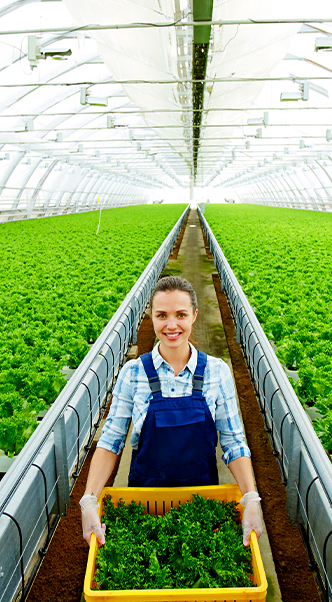Within the agricultural sector, a lot of jargon gets thrown about, and it is often hard to distinguish between them. Agriculture is an umbrella term for most practices within farming - but what is intensive agriculture, and how does this differ from horticulture?
Within the agricultural sector, a lot of jargon gets thrown about, and it is often hard to distinguish between them. Agriculture is an umbrella term for most practices within farming - but what is intensive agriculture, and how does this differ from horticulture?
Agriculture is defined as the science of cultivating soil, growing crops and raising livestock. It includes preparing plant and animal products for people to use, and the subsequent distribution to markets. In a nutshell, agriculture is responsible for the food we eat and the clothes we wear. In recent years, the landscape of agriculture has been changing, as more and more farmers are joining together and pledging to reach Net Zero.
What is Intensive Agriculture?
Intensive agriculture, otherwise known as industrial agriculture, is farming which, naturally, involves an intensive amount of work, aiming to achieve the maximum possible output. Intensive farming came about through farmers adding external pressures to meet the demands which intermediaries produce at an enormous scale. Without intervention and development of technologies, systems and processes, the current system of intensive agriculture may not be able to continue for many more years. Put simply, intensive agriculture aims to increase the harvested produce to the greatest possible extent, per land area. This comes with risk, and is harder to do sustainably.
What is Horticulture?
On the other hand, horticulture, a subdivision of agriculture, is the science behind the aesthetics of floral plants, and the science and commercialisation of producing edible fruits and vegetables, herbs, and ornamental plants. It is also known as the much more commonly known term: gardening.
Horticulture is increasingly growing in popularity due to its numerous benefits to our population, and the world around us.
Like agriculture, horticulture is also an umbrella term for a lot of different types of farming methods. Types of horticulture include: Olericulture (vegetables), Pomology (nuts and fruit), Viticulture (grapes mainly for wine making), Floriculture (flowering plants and ornamental trees), Turf Management (maintenance of turf grass, sports and amenity), Landscape Horticulture (production and care of plants specifically for landscape architecture) and Postharvest Physiology (to slow down spoilage during transportation and storage).
The Key Differences Between Agriculture and Horticulture
5 Facts About Horticulture
-
What does horticulture consist of? Well, it includes: cultivation, plant propagation, breeding of plants, production of crops, plant physiology, biochemistry, and genetic engineering—mainly vegetables, trees, flowers, turf, shrubs, fruits and nuts.
-
One particularly appealing element of horticulture is that, naturally, it is all plant-based. No animals are used in food production, as the produce is all part of your nutritious 5 a day! Horticulture appeals to consumers who want to reduce their meat consumption for ethical reasons, religion or sustainability.
-
Horticulture isn’t limited to large farms. Instead, it is carried out in a much smaller environment. It can simply be done in your garden, for example, which has a whole range of benefits.
-
Also, it removes the need for transportation miles for produce, as trucks can transport many more seeds than they could vegetables or plants. Experienced gardeners could even learn to collect the seeds at the end of each cycle to grow more. This additionally means that it offers a more sustainable alternative to agriculture. The reduced transportation miles, paired with the lesser ‘mechanical’ aspect of the process - all about those green fingers! - means that it is more Mother Earth-friendly.
-
Some suggest that gardening is therapeutic and has shown to be great for mental health in reducing symptoms of depression. In times of pandemics and political unrest, it is plain to see the reasons behind horticulture’s popularity.
5 Facts About Intensive Agriculture
-
Agriculture has human consumption at its heart, whilst horticulture involves plants that cannot be eaten. With the growing global population and external pressures to meet demands, sectors within agriculture need to get creative and rely on expensive industrial equipment to keep up with the times - and the demand. Enter intensive agriculture!
-
Intensive agriculture typically requires large areas of land, while also being incredibly labour intensive. Intensive farming, in theory, could be carried out on smaller farms - as the general idea is to maximise output for smaller cubic metres - however, larger spaces are preferable simply due to larger landscapes resulting in greater returns.
-
Depending on the country the farm operates in, they can often cut down mass amounts of trees and habitats to make space for farmland. That said, do not mistake this as standard practice. A lot of countries within Europe do not need to cut down trees to make space. In the UK, for example, most of the land is already ideal for farms, and there is no need for deforestation.
-
Intensive agriculture is a lot more ‘mechanical’, so to speak, than horticulture. In a nutshell, intensive farming requires powerful machinery to meet demands, while, in contrast, horticulture simply stems from human hands.
-
Increasingly, there are technological advances that allow for more sustainable production within intensive farming. But will that be enough?
One of the main questions raised is: In order to meet Net Zero targets and help feed the rising global population, should the global population be taught about horticulture methods? Should we be encouraged to return to our roots and grow food in our back gardens or allotments, as opposed to relying on farming? Or will the agricultural industry continue to pave the path to a more sustainable future through innovation? Time will only tell.






